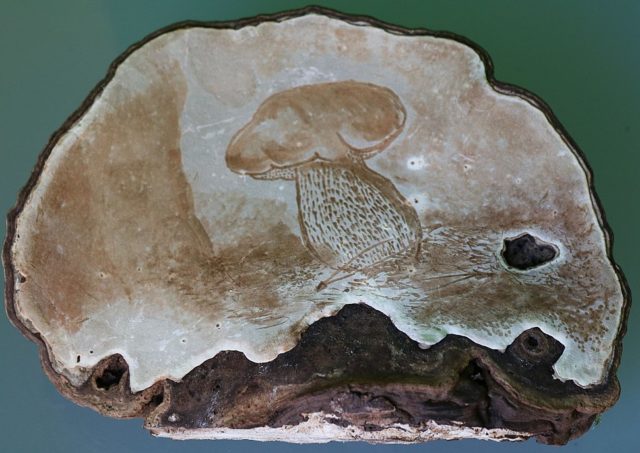Content
The flat polypore (Ganoderma applanatum or lipsiense), also called the artist's mushroom, belongs to the Polyporovye family and the Ganoderm genus. This is a classic example of a perennial tree fungus.
Scientific names given to the fruiting body by various mycologists:
- first described and classified as Boletus applanatus by Christian Person in 1799;
- Polyporus applanatus, 1833;
- Fomes applanatus, 1849;
- Placodes applanatus, 1886;
- Phaeoporus applanatus, 1888;
- Elfvingia applanata, 1889;
- Ganoderma leucophaeum, 1889;
- Ganoderma flabelliforme Murrill, 1903;
- Ganoderma megaloma, 1912;
- Ganoderma incrassatum, 1915;
- Friesia applanata, 1916;
- Friesia vegeta, 1916;
- Ganoderma gelsicola, 1916
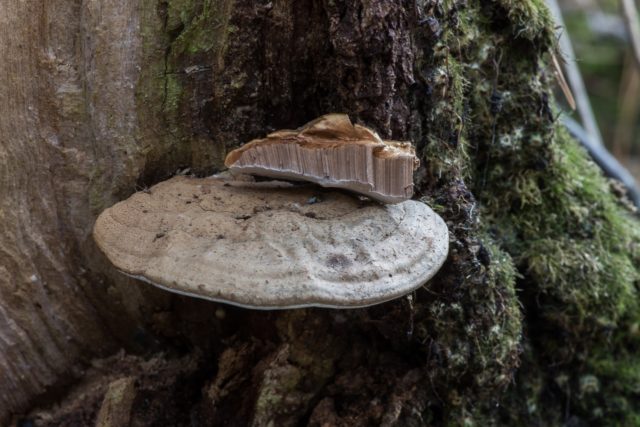
The mushroom has been growing in one place for many years, reaching gigantic proportions.
Description of the flat tinder fungus
The cap of the mushroom is fleshy, sessile, and grows to the substrate with its flat side. Prostate-rounded, tongue-shaped or petal-shaped, hoof-shaped or disc-shaped. The surface is usually flat, with straight or raised edges. It has concentric scars-stripes diverging from the place of growth, it can be slightly folded, wavy. Reaches 40-70 cm in diameter and up to 15 cm thick at the base.
The surface is dense, matte, slightly rough. The color can be different: from gray-silver and cream-beige to chocolate and brown-black. Sometimes overgrown mushrooms take on bright burgundy-red hues. The leg is absent even in its infancy.
Spores are rusty-brown in color, often covering the top of the mushroom with a kind of powdery coating. The edge is rounded, in young specimens it is thin, white. The spongy underside is white, creamy silver or light beige. The slightest pressure causes a darkening to a gray-brown color.
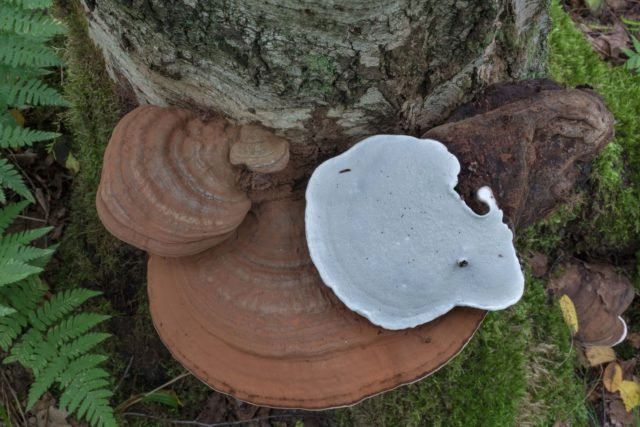
Fruit bodies are located in small tight groups, forming a kind of canopy
Where and how it grows
Tinder fungus is common in temperate and northern latitudes: in Russia, the Far East, Europe and North America. Active growth begins in May and continues until September. You can see the mushroom at any time of the year, even in winter frosts, if you remove the snow from the tree.
This tree parasite settles mainly on deciduous trees. It can take a liking to both a living damaged tree and dead wood, stumps, dead wood and fallen trunks.
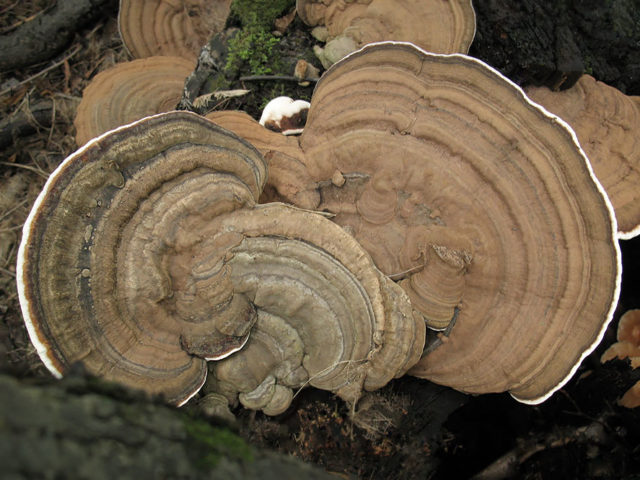
Tinder fungus does not climb high, usually it settles at the very roots or in the lower part of the tree
Doubles and their differences
Unique appearance and stunning dimensions eliminate confusion in the definition of flat tinder fungus. There are some similarities with several species.
Lacquered polypore. Inedible. Differs in a wax cap and smaller size.

Lacquered polypores are widely used in Chinese folk medicine.
Southern polypore. Inedible, non-toxic. Differs in large size and glossy surface.
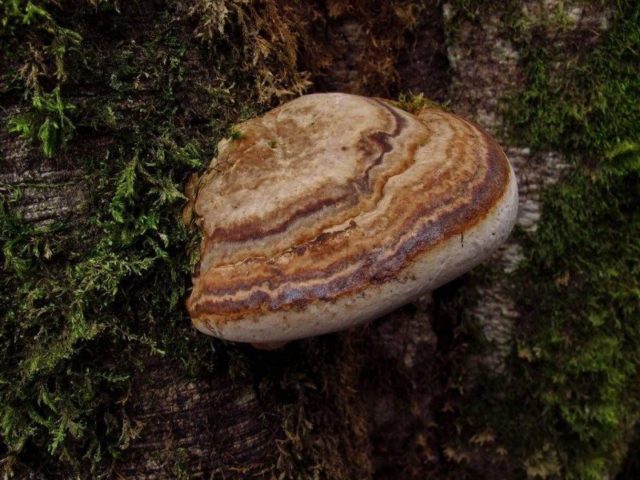
Its edge, unlike the flat tinder fungus, is gray-brown
Is the mushroom edible or not
The flat polypore (Ganoderma applanatum) is classified as an inedible mushroom. It has a tough, corky flesh that is tasteless and odorless, which reduces its culinary value.
The healing properties of the flat tinder fungus
Being in essence a parasite that destroys trees, flat tinder fungus is widely used in folk medicine in a number of countries. It is especially appreciated in China. Its beneficial properties:
- enhances immunity and fights viral diseases;
- normalizes blood pressure, reduces the level of acidity in the digestive tract;
- relieves inflammation in the joints and internal organs, providing a beneficial effect for rheumatic pains, asthma, bronchitis;
- normalizes blood sugar and promotes the production of insulin;
- improves the state of the nervous system, has an anti-allergenic effect;
- is a good tool for the prevention of cancer, neoplasms, and it is also useful to take it as part of a complex treatment of tumors.
The use of a flat tinder fungus in traditional medicine
Tinctures for alcohol, decoctions, powders, extracts are made from flattened Ganoderma. It is used for pulmonary diseases, diabetes, inflammatory processes and oncology. To increase immunity and improve the work of the cardiovascular system, healthy tea is prepared from the fruit body.
The collected fruit bodies must be dried at a temperature of 50-70 degrees, grind into powder. Store in a dry hermetically sealed container out of sunlight. Tea from tinder fungus (Ganoderma applanatum)
Required Ingredients:
- mushroom powder - 4 tbsp. l .;
- water - 0.7 l.
Pour the powder with water, bring to a boil and cook over low heat for 5-10 minutes. Pour into a thermos, close and leave for half a day. Tea can be taken 3 times a day, 40-60 minutes before meals, 2 tbsp. l. The course of treatment is 21 days, after which a weekly break should be taken.
This tea is effective in removing toxic substances from the body and stimulating the digestive system.
Some interesting facts
This fruiting body has several unique characteristics:
- The cut flat polypore attached to the wound promotes rapid healing and tissue regeneration.
- The flat polypore can reach enormous sizes for several years, while the light surface of the heminophore remains rounded-even and smooth.
- On the body of an old mushroom, young flat tinder fungi can sprout, creating bizarre designs.
- Craftsmen create stunning paintings on the inner porous surface of large specimens. A match, a thin stick or a rod is enough for this.
Conclusion
Tinder fungus is a mushroom widespread in the Northern Hemisphere. It has healing properties and is used in Chinese traditional medicine. There are references to the treatment with its help in ancient Greek sources, in particular, the healer Dioscorides recommended it as an excellent remedy for cleansing the body and nervous disorders. You can find it in deciduous forests, on lying trunks, stumps and dead wood. It is unsuitable for food because of its tough, tasteless pulp. He has no poisonous counterparts. Some types of tinder fungus have common features, but it is difficult to confuse them.
